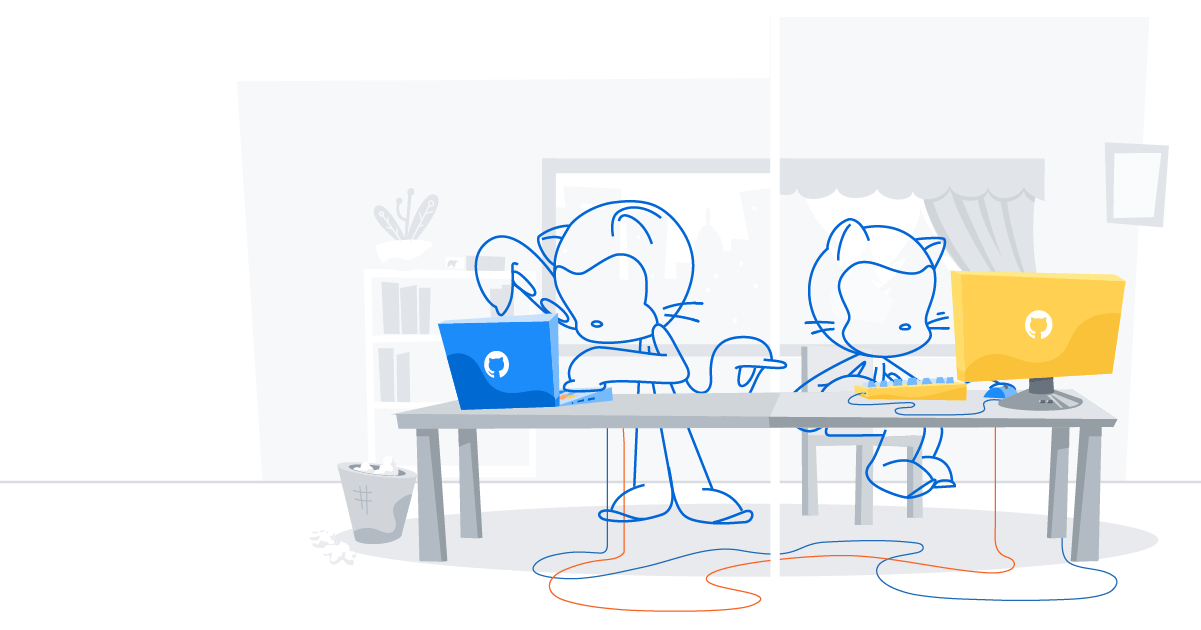Remote work: Sales and Support on being customer-centric while working remotely
Sales and Support leaders share advice and strategies to help you navigate a remote-first customer approach.

Being part of a remote-first workplace, the GitHub Sales and Support teams have experience in building relationships with each other outside of the traditional office. Now, they are adapting their remote working best practices to customer relationships as companies continue to work from home. At GitHub, we’re sharing the lessons learned from virtual interactions and the efficiencies we’ve found during this time to better interact with customers long-term.
Sue Morris, GitHub’s VP of Global Support, and her team are focused on the service experience. As Sue notes, “Our support team ethos is that one of your teammates will always have your back. As we all work together to balance tending to our families, we’re also looking after teammates to ensure that we deliver for our customers.” Matthew McCullough, VP of Field Services, has spent the last 10 years passionately educating customers about GitHub’s platform and giving developers the tools to do better work so they are empowered in their daily jobs. In this edition of our remote work series, Sue and Matthew share their wisdom on how to manage Support and Sales Engineering teams with an eye towards the future of work.
What’s changed for your teams since the COVID-19 outbreak started?
Sue: We find ourselves building relationships with people remotely, which is like flexing a new muscle for us. Although the Support Team was fully remote before the COVID outbreak, there were still moments during the year where we would meet in-person, such as our company summits, meetups, regional onsites, conferences, and events. This gave us multiple opportunities throughout the year to get together, which we really appreciated and helped us learn from each other. You don’t realize how much you miss those opportunities for personal interaction until they’re gone.
Matthew: In the past, there was a heavy focus on having a physical visit with the customer before a proof of concept project kicked off. The customer would say, “Hey Matthew, come sit with me for a few days as we work through this project plan, get the tech bits set up, make sure it fits our environment, run some tests, and maybe present to a small boardroom of decision-makers in our company.” When we tried to make this process virtual before COVID-19, some customers pushed back, feeling that we wouldn’t be able to fully understand their culture and needs if we didn’t meet in-person. What this global pandemic has done is put a lot of in-person-first and virtual-first companies on equal footing, since many are beholden to a similar set of rules and parameters of distancing and remote work. My team recently spoke to a customer who has always insisted their vendors conduct proof of concept presentations, technical validation, and any sort of decision-making in-person. Now due to travel restrictions, we recently completed a virtual decision-making meeting, and I think everyone in attendance, on both sides, admitted it was both more efficient and effective than some of our in-person meetings. It makes me wonder if we’ll ever go back to that stodgier “must-be-in-person” state since we can no longer use the argument that virtual presentations won’t work. In the same vein, it’s no longer feasible to be with a customer in front of their computer, to guide them and provide hands-on support. So we’ve increasingly turned to workarounds through screen sharing to explore support situations together. The world is forever altered to be more digital-collaboration-ready given these shared COVID-19 experiences.
What were some of the perceived benefits of working in an office?
Matthew: More than 80 percent of the Solutions Engineering Team was working remotely before COVID-19, with just a small group of Inside Solution Engineers formally based in our San Francisco headquarters. At the time, it seemed that being in the office offered more of an opportunity for collaborating and coaching. But as the line blurs between Inside Sales and Field Sales positions in this COVID-19 era, those HQ-based team members found the nature of their work becoming remote organically and it is unlikely to ever fully reverse. The mindset is that they are “experts out in the field” even if that “field” is just a video conference call away, rather than an airplane ride. They are more able than ever to deliver precisely the right technical info to our customers in a timely fashion.
What’s your best advice for Sales and Support teams during this time?
Sue: As a manager, the best advice I can offer here is to make sure you empathize with the human side of your team and the challenges that people are facing at the moment while allowing them a working environment where we all support each other, and recognize that our customers are dealing with many of the same challenges. When it comes to customer support, we’re fortunate that we have a ticket-based support model, which gives us the flexibility to work the hours that suits each individual—also key as a global team. We’re able to use the tools that help us understand exactly where everyone is at in the process, and have made it a point to make our training sessions more flexible for anyone connecting across the globe to understand. Finally, given the multiple time zones that span our team, we run every all-hands and regular team meetings twice so everyone has a chance to join the meetings as they can. The meetings are also recorded for those who cannot attend. This ultimately gives our team control of their schedule and helps us prioritize timely service to our customers.
Matthew: My advice is to make sure you have regular checkpoints with your team. When our team worked in the office, status updates were easier to conduct organically–but now that we’re all working from home, you have to become more explicit about status and checkpoints, defaulting to writing them down and giving them a URL. This helps include virtual participants in other time zones and to increase the perceived size of the engaged team for any given challenge we’re working on. I’ve also found that we’ve become a lot more creative with our time when it comes to watercooler-type chats via video conferencing. For example, we have some chatops tools written by the Solutions Engineering team that let you list anyone that’s joined our “Watercooler” perpetual video conference room. If the room is empty, you can hop on chat, @mention a few people from your team to let them know that you’re about to start a five-minute catch-up. Colleagues will then catch up for a few minutes and sometimes move on to a status update. The entire process is very short and low-maintenance and helps humanize the workday. With our approach, it’s as if I just entered the “breakroom” for a coffee and a doughnut, talk for a few minutes, and then move on. It no longer feels like a chore or a burden, but rather a quick way to refresh.
Do you envision any changes with your team once this pandemic is over?
Matthew: Now that we understand the advantages of online meetings, it will be hard to go back. I anticipate our team having shorter default-to-virtual checkpoints with customers. This may not reduce the cumulative time spent in meetings overall, but we may find that meeting six times in half-hour blocks is more consistent and beneficial versus one, three-hour meeting. Even if it’s not a net reduction in time, it’s the granularity of the touchpoints throughout that ultimately allows for faster completion and more consistent progress. As humans, we are imperfect at communicating. So it’s better to have more verification checkpoints in place to know you’re headed in the right direction.
Sue: There’s certainly a benefit for us working remotely since we have access to a broader talent pool by not restricting where they work or even how they work, as Matthew noted. We’re able to cast a wide net as we look for people who truly love developers, love GitHub, and want to come as they are and do what they love. We’ve built a very strong team culture here at GitHub where we all support one another, while still looking after the customer. And while working from home in a support organization has real benefits, someday soon we can’t wait to meet up with our colleagues and give everybody a big hug.
Want to learn more about best practices for working remotely? Check back next week as we continue our series to help you make the most of working in a remote environment from our next interview. And share these useful tips with others who may be new to working remotely.
Explore the remote work series
Tags:
Written by
Related posts

Apply now for GitHub Universe 2023 micro-mentoring
As part of our ongoing commitment to accelerate human progress through Social Impact initiatives, we’re offering students 30-minute, 1:1 micro-mentoring sessions with GitHub employees ahead of Universe.

The 2023 Open Source Program Office (OSPO) Survey is live!
Help quantify the state of enterprise open source by taking the 2023 OSPO survey.

Godot 4.0 Release Party 🎉
We are delighted to host the Godot 4.0 Release Party at GitHub HQ on Wednesday, March 22 from 6:30 pm to 9:30 pm. And you’re invited!